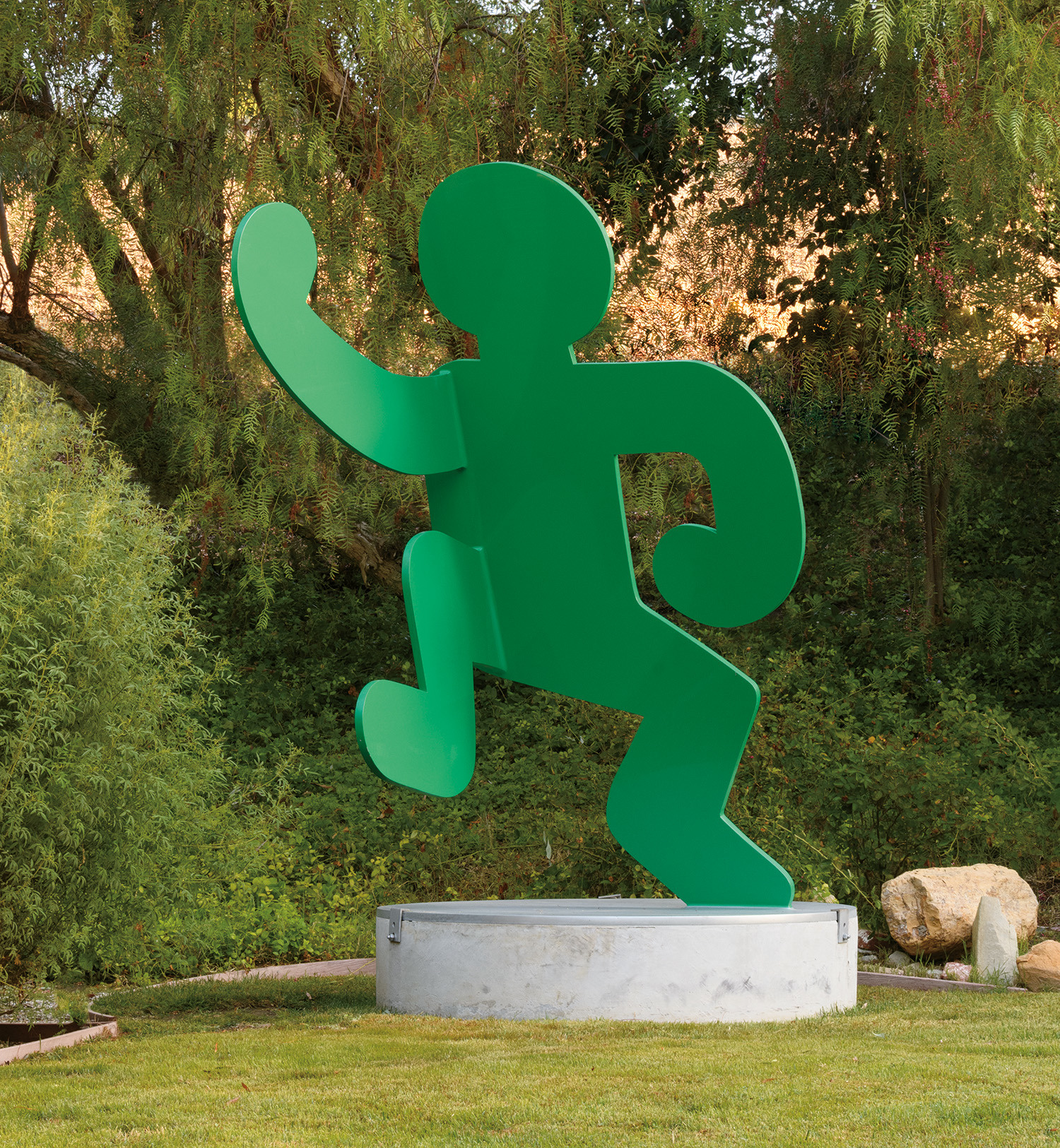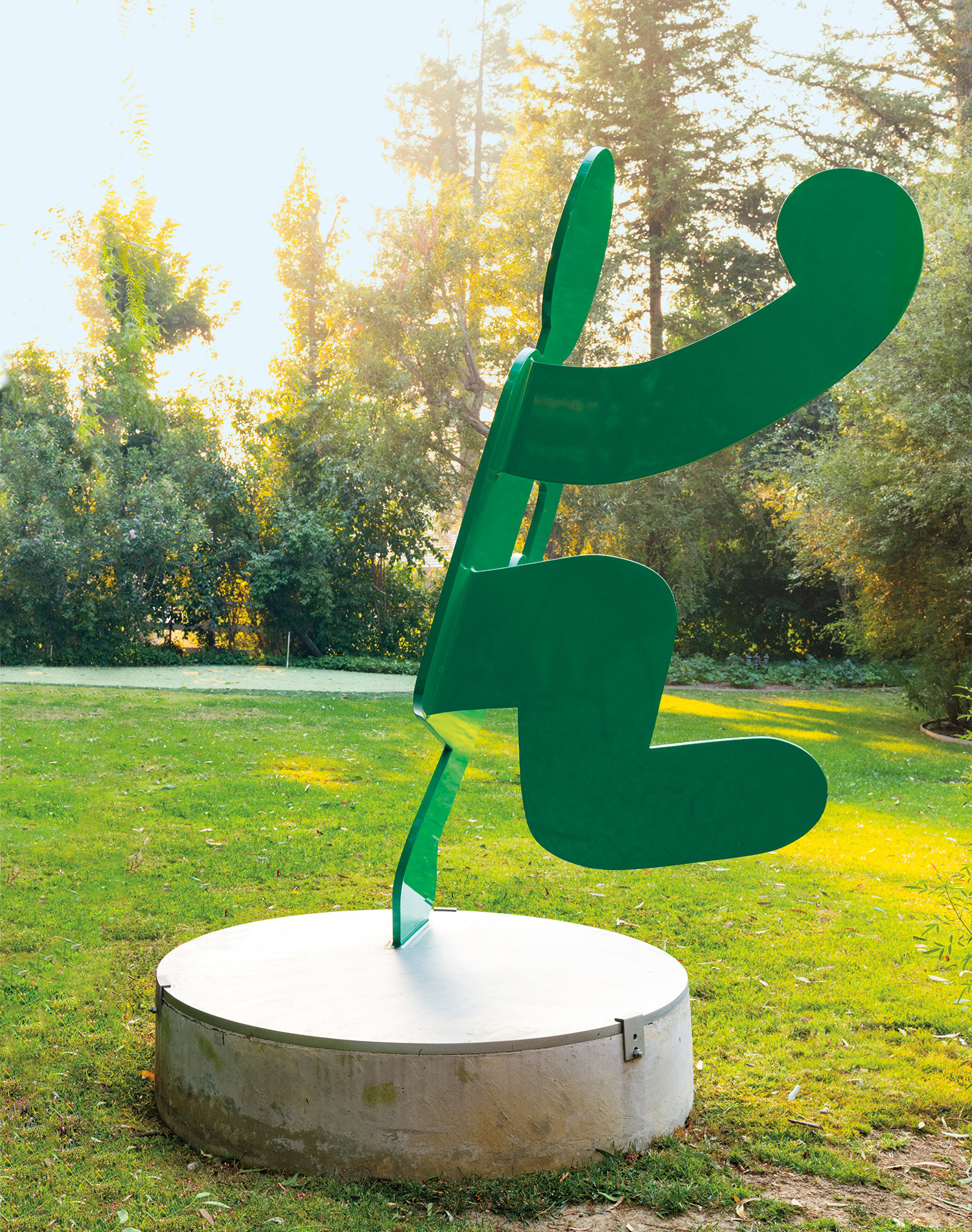



Property from an Important West Coast Collector
168
Keith Haring
Untitled (Self Portrait)
incised with the artist's signature, number, date and foundry mark "K Haring 1989 4/5 acf" on the base
painted aluminum
94 1/2 x 58 x 79 in. (240 x 147.3 x 200.7 cm.)
Executed in 1989, this work is number 4 from an edition of 5 plus 1 artist's proof.
Full-Cataloguing
“A painting, to a degree, is still an illusion of a material. But once you cut this thing out of steel and put it up, it is a real thing…It has a kind of power that painting doesn’t have. It has this permanent, real feeling that will exist much much much longer than I will ever exist, so it’s a kind of immortality.” Keith Haring
Soaring nearly eight feet high and frozen in ecstatic dance, Keith Haring’s Untitled (Self Portrait), 1989, offers a jubilant celebration of life. Transposing his iconic ideogram into three-dimensional form, Haring here exhibits his mastery of the sculptural medium within a period of just four years. It was at Tony Shafrazi’s suggestion that Haring ventured into the sculptural medium, taking his distinctive graphic form into the third dimension. As David Galloway has observed, Haring’s sculptures, “like virtually every other aspect of his comet-like career…reveal a formal evolution of break-dance speed” (David Galloway, Keith Haring, Sculptures, Painting and Works on Paper, exh. cat., Ben Brown Fine Arts, London, 2005, p. 21). Freely sculpting models from cardboard with a pair of scissors, Haring embraced an intuitive and self-assured hands-on approach to creating sculpture. After presenting his first free-standing sculptures at Leo Castelli Gallery, New York, in 1985, Haring agreed to collaborate with the Hans Mayer Gallery in Dusseldorf to produce his so-called Dusseldorf Sculptures, which were notably exhibited at Münster’s Skulpturen Projekte in 1987 along with the works of such stalwarts as Richard Serra and Sol Lewitt.
Despite their monumentality, Haring’s sculptures maintain a similar nimbleness of line that one finds in his drawings and paintings. While clearly reflecting his graffiti-inspired idiom, these works also connect to a larger sculptural lineage that runs the spectrum of Pablo Picasso and Julio González, as well as Alexander Calder, Yves Tinguely and Claes Oldenburg. Haring particularly appreciated Calder’s work for its “simple, clear, poetic quality to which anyone can respond. Kids like him, too, because the work has spirit, comes from the spirit” (Keith Haring, quoted in David Galloway, Keith Haring, Sculptures, Painting and Works on Paper, exh. cat., Ben Brown Fine Arts, London, 2005, p. 23).
In 1988, Haring was diagnosed with AIDS and there is a latent sense of reckoning with his own mortality in this self-portrait, arguably the most intimate of all subjects in art. Presenting us with a figure mid-dance, Untitled (Self Portrait) captures the joie-de-vivre of an artist living in the present. As Kenny Scharf, Haring’s roommate in the early 1980s recalled, “From the first moment we met, dance was very much a part of our lives” (Kenny Scharf, quoted in Keith Haring, exh. cat., Whitney Museum of American Art, New York, 1997, p. 214). Haring, a regular at such legendary New York clubs as the Paradise Garage and the Mudd Club, openly acknowledged the connection of dance in his jubilant sculptures. As David Galloway highlighted in regards to the present work, “…Haring’s own Self Portrait numbers among these ebullient figures, which often give the feeling of vigorous motion momentarily ‘frozen’ by a strobe light” (David Galloway, Keith Haring, Sculptures, Painting and Works on Paper, exh. cat., Ben Brown Fine Arts, London, 2005, p. 26).
In the face of death, Haring embraced art as a celebration of life and humanity. Created just a year before Haring passed away due to AIDS-related complications, Untitled (Self Portrait) perfectly captures Haring’s statement on the impact of sculpture: “It has a kind of power that painting doesn’t have. It has this permanent, real feeling that will exist much much much longer than I will ever exist, so it’s a kind of immortality” (Keith Haring, quoted in Daniel Drenger, “Art and Life: An Interview with Keith Haring”, Columbia Art Review, Spring 1988, p. 49).
Soaring nearly eight feet high and frozen in ecstatic dance, Keith Haring’s Untitled (Self Portrait), 1989, offers a jubilant celebration of life. Transposing his iconic ideogram into three-dimensional form, Haring here exhibits his mastery of the sculptural medium within a period of just four years. It was at Tony Shafrazi’s suggestion that Haring ventured into the sculptural medium, taking his distinctive graphic form into the third dimension. As David Galloway has observed, Haring’s sculptures, “like virtually every other aspect of his comet-like career…reveal a formal evolution of break-dance speed” (David Galloway, Keith Haring, Sculptures, Painting and Works on Paper, exh. cat., Ben Brown Fine Arts, London, 2005, p. 21). Freely sculpting models from cardboard with a pair of scissors, Haring embraced an intuitive and self-assured hands-on approach to creating sculpture. After presenting his first free-standing sculptures at Leo Castelli Gallery, New York, in 1985, Haring agreed to collaborate with the Hans Mayer Gallery in Dusseldorf to produce his so-called Dusseldorf Sculptures, which were notably exhibited at Münster’s Skulpturen Projekte in 1987 along with the works of such stalwarts as Richard Serra and Sol Lewitt.
Despite their monumentality, Haring’s sculptures maintain a similar nimbleness of line that one finds in his drawings and paintings. While clearly reflecting his graffiti-inspired idiom, these works also connect to a larger sculptural lineage that runs the spectrum of Pablo Picasso and Julio González, as well as Alexander Calder, Yves Tinguely and Claes Oldenburg. Haring particularly appreciated Calder’s work for its “simple, clear, poetic quality to which anyone can respond. Kids like him, too, because the work has spirit, comes from the spirit” (Keith Haring, quoted in David Galloway, Keith Haring, Sculptures, Painting and Works on Paper, exh. cat., Ben Brown Fine Arts, London, 2005, p. 23).
In 1988, Haring was diagnosed with AIDS and there is a latent sense of reckoning with his own mortality in this self-portrait, arguably the most intimate of all subjects in art. Presenting us with a figure mid-dance, Untitled (Self Portrait) captures the joie-de-vivre of an artist living in the present. As Kenny Scharf, Haring’s roommate in the early 1980s recalled, “From the first moment we met, dance was very much a part of our lives” (Kenny Scharf, quoted in Keith Haring, exh. cat., Whitney Museum of American Art, New York, 1997, p. 214). Haring, a regular at such legendary New York clubs as the Paradise Garage and the Mudd Club, openly acknowledged the connection of dance in his jubilant sculptures. As David Galloway highlighted in regards to the present work, “…Haring’s own Self Portrait numbers among these ebullient figures, which often give the feeling of vigorous motion momentarily ‘frozen’ by a strobe light” (David Galloway, Keith Haring, Sculptures, Painting and Works on Paper, exh. cat., Ben Brown Fine Arts, London, 2005, p. 26).
In the face of death, Haring embraced art as a celebration of life and humanity. Created just a year before Haring passed away due to AIDS-related complications, Untitled (Self Portrait) perfectly captures Haring’s statement on the impact of sculpture: “It has a kind of power that painting doesn’t have. It has this permanent, real feeling that will exist much much much longer than I will ever exist, so it’s a kind of immortality” (Keith Haring, quoted in Daniel Drenger, “Art and Life: An Interview with Keith Haring”, Columbia Art Review, Spring 1988, p. 49).
Keith Haring
American | B. 1958 D. 1990Haring's art and life typified youthful exuberance and fearlessness. While seemingly playful and transparent, Haring dealt with weighty subjects such as death, sex and war, enabling subtle and multiple interpretations.
Throughout his tragically brief career, Haring refined a visual language of symbols, which he called icons, the origins of which began with his trademark linear style scrawled in white chalk on the black unused advertising spaces in subway stations. Haring developed and disseminated these icons far and wide, in his vibrant and dynamic style, from public murals and paintings to t-shirts and Swatch watches. His art bridged high and low, erasing the distinctions between rarefied art, political activism and popular culture.